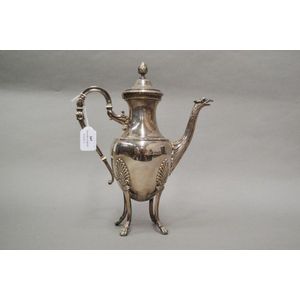French Empire Coffee Pot with Griffin Spout and Ivory Spacers
Antique French silver plated Empire style coffee pot with griffin head spout and ivory heat spacers, approx 30 cm high
You must be a subscriber, and be logged in to view price and dealer details.
Subscribe Now to view actual auction price for this item
When you subscribe, you have the option of setting the currency in which to display prices to $Au, $US, $NZ or Stg.
This item has been sold, and the description, image and price are for reference purposes only.
- Ivory - Ivory is a hard white material that comes from the tusks of elephants, mammoth, walrus and boar, or from the teeth of hippopotamus and whales. The ivory from the African elephant is the most prized source of ivory. Although the mammoth is extinct, tusks are still being unearthed in Russia and offered for sale.
Ivory has been used since the earliest times as a material for sculpture of small items, both in Europe and the east, principally China and Japan.
In Asia ivory has been carved for netsuke, seals, okimono, card cases, fan supports, animals and other figures and even as carved tusks.
In the last 200 years in Europe ivory has been used to carve figures, for elaborate tankards, snuff boxes, cane handles, embroidery and sewing accessories, in jewellery and as inlay on furniture. Its more practical uses include being used for billiard balls, buttons, and a veneers on the top of piano keys.
The use and trade of elephant ivory have become controversial because they have contributed to Due to the decline in elephant populations because of the trade in ivory, the Asian elephant was placed on Appendix One of the Convention on International Trade in Endangered Species (CITES), in 1975, and in January 1990, the African elephant was similarly listed. Under Appendix One, international trade in Asian or African elephant ivory between member countries is forbidden. Unlike trade in elephant tusks, trade in mammoth tusks is legal.
Since the invention of plastics, there have been many attempts to create an artificial ivory - Griffin / Griffon / Gryphon - A griffin, also known as a griffon or gryphon, is a mythical creature with the body of a lion and the head of an eagle. It is typically depicted as a powerful and majestic beast, with the body and legs of a lion and the head, wings, and talons of an eagle. The griffin is widely recognized as a symbol of strength, courage, and guardianship, and has been used in a variety of cultures throughout history.
In ancient mythology, the griffin was often associated with the gods and was considered a symbol of divine power. In ancient Greece, for example, the griffin was associated with the sun god Helios, while in ancient Egypt, it was associated with the goddess Hathor. In medieval European heraldry, the griffin was used as a symbol of strength, valour, and protection, and was often featured on the coats of arms of noble families. - Empire Style - The Empire style was a version of neo-classicism popular from 1800 to 1830, coinciding with the rule of Napoleon I from 1840-15. In England the style corrosponds with the Regency style and in the United States to the Federal style.
The style is inspired by classical Rome and Greece, as reflected in the decorative motifs in the the design such as paterae, guilloches, acanthus and swags, and pieces are lavishly decorated with applied gilded decoration.
This item has been included into following indexes:
Visually similar items

Antique French silver plated tea service with tongs (5)
Sold by
in
for
You can display prices in $Au, $US, $NZ or Stg.

Four piece silver plate coffee set, 28 cm high and smaller
Sold by
in
for
You can display prices in $Au, $US, $NZ or Stg.

A Victorian sterling silver four piece tea and coffee service
Sold by
in
for
You can display prices in $Au, $US, $NZ or Stg.

Sterling silver coffee pot, London 1799, maker W.B, 23 cm
Sold by
in
for
You can display prices in $Au, $US, $NZ or Stg.
